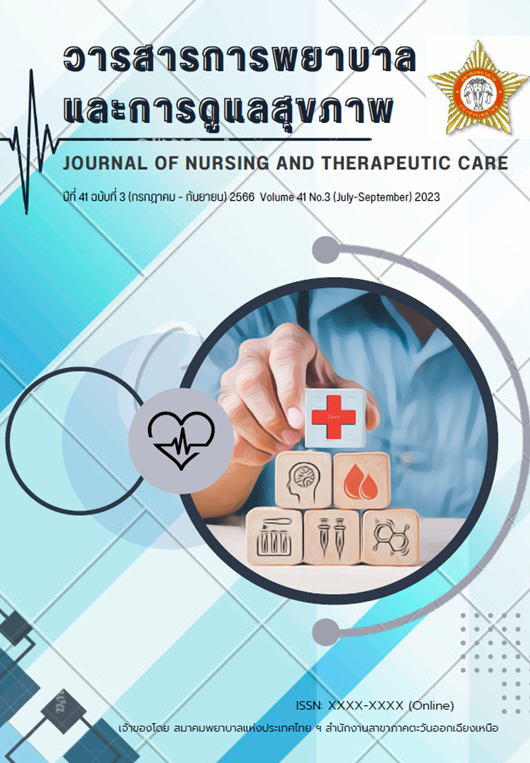การพยาบาลผู้ป่วยโรคโควิด-19 ที่มีภาวะหายใจล้มเหลวแบบเฉียบพลัน ตามแนวคิดทางการพยาบาล FANCAS : กรณีศึกษา 2 ราย
คำสำคัญ:
การพยาบาลวิกฤต, โรคโควิด-19 ภาวะหายใจล้มเหลวเฉียบพลันบทคัดย่อ
การศึกษาแบบกรณีศึกษานี้มีวัตถุประสงค์เพื่อศึกษาการใช้กระบวนการพยาบาลตามแนวคิดทางการพยาบาลของแฟนคัส ในการพยาบาลผู้ป่วยโรคโควิด-19 ที่มีภาวะหายใจล้มเหลวแบบเฉียบพลัน ศึกษาในผู้ป่วย 2 ราย ที่เข้ารับการรักษาที่ในหอผู้ป่วยวิกฤตระบบทางเดินหายใจ โรงพยาบาลมหาวิทยาลัยเทคโนโลยีสุรนารี เครื่องมือที่ใช้ประเมินผู้ป่วย ได้แก่ แบบประเมินภาวะสุขภาพของ FANCAS วิเคราะห์ข้อมูลโดยการวิเคราะห์เนื้อหา ผลการศึกษาพบว่า ผู้ป่วยโรคโควิด-19 ได้รับการพยาบาลตามข้อวินิจฉัย การพยาบาลตามแนวคิดทางการพยาบาล FANCAS ดังนี้ 1) ด้านสมดุลน้ำ: มีภาวะไม่สมดุลของสารน้ำและเกลือแร่ในร่างกาย 2) ด้านการหายใจ: มีภาวะพร่องออกซิเจนเนื่องจากประสิทธิภาพการแลกเปลี่ยนก๊าซลดลง 3) ด้านภาวะโภชนาการ: เสี่ยงต่อภาวะทุพโภชนาการเนื่องจากแบบแผนการรับประทานอาหารเปลี่ยนแปลง 4) ด้านการติดต่อสื่อสาร: ไม่สามารถสื่อสารหรือพูดคุยเนื่องจากการใส่ท่อช่วยหายใจ และมีความวิตกกังวล 5) ด้านการทำกิจกรรม: มีภาวะพร่องสุขวิทยาส่วนบุคคลเนื่องจากความสามารถในการช่วยเหลือตนเองลดลง มีการจำกัดกิจกรรมของผู้ป่วยเนื่องจากการใส่ท่อช่วยหายใจ และ 6) ด้านการกระตุ้น: เสี่ยงต่อภาวะช็อคจากการติดเชื้อ และอาจเกิดการแพร่กระจายเชื้อสู่ผู้อื่น
ผลการศึกษาพบว่า แนวคิดทางการพยาบาล FANCAS สามารถนำมาประยุกต์ใช้ในการดูแลผู้ป่วยโรคโควิด-19 ที่มีภาวะการหายใจล้มเหลวเฉียบพลันได้อย่างรวดเร็วและเหมาะสม กรณีศึกษาทั้งสองรายได้รับการพยาบาลตามข้อวินิจฉัยการพยาบาลและมีการวินิจฉัยทางการพยาบาลที่คล้ายคลึงกัน ดังนั้นในทางปฏิบัติ พยาบาลจำเป็นต้องพัฒนาทักษะในการประเมินผู้ป่วยตามแนวคิดทางการพยาบาล FANCAS เพื่อให้เข้ากันได้กับแนวทางการรักษาโรคที่กำลังพัฒนาอยู่อย่างต่อเนื่อง
Downloads
เอกสารอ้างอิง
Kirby T. Evidence mounts on the disproportionate effect of COVID-19 on ethnic minorities. Lancet Respir Med. 2020;8(6):547–8.
Department of Disease Control, Ministry of Public Health. Guidelines for Medical Practice, Diagnosis, and Treatment of Coronavirus Disease 2019 [internet]. 2020. [cited 2021 Oct 16]. Available from: https://ddc.moph.go.th/covid19-dashboard/ (in Thai)
Riou J, Althaus CL. Pattern of early human-to-human transmission of Wuhan 2019 novel coronavirus (2019-nCoV). Euro Surveill. 2020;25(4):2000058.
Wu C, Chen X, Cai Y, Xia J, Zhou X, Xu S, et al. Risk factors associated with acute respiratory distress syndrome and death in patients with coronavirus disease 2019 pneumonia in Wuhan, China. JAMA Intern Med. 2020;180(7):934-43.
Hasan SS, Capstick T, Ahmed R, Kow CS, Mazhar F, Merchant HA, et al. Mortality in COVID-19 patients with acute respiratory distress syndrome and corticosteroids use: A systematic review and meta-analysis. Expert Rev Respir Med. 2020;14(11):1149-63.
Bernal JL, Andrews N, Gower C, Robertson C, Stowe J, Tessier E, et al. Effectiveness of the Pfizer-BioNTech and Oxford-AstraZeneca vaccines on Covid-19 related symptoms, hospital admissions, and mortality in older adults in England: Test negative case-control study. Siriraj med Bulletin. 2021;13(373):n10080.
Songmuang J. Acute respiratory distress syndrome. Siriraj Medical Bulletin. 2017;10(3):174-9. (in Thai)
Thongsan S. Case Study: Nursing care of corona virus 2019 with acute respiratory distress syndrome patient at Kalasin hospital. Journal of Health and Environmental Education. 2022;7(1): 108-119. (in Thai)
Holloway M. Nursing the Critically ILL Adult. California: Addison-Wesley; 1979.
Thongngam S, Phumoon S, Rattanarat R. Nursing care for patients with COVID-19 in the isolation ward Siriraj Hospital. Siriraj Medical Bulletin. 2020;13(3):81-90 (in Thai)
Kyranou M, Cheta C, Pampoulou E. Communicating with mechanically ventilated patients who are awake. A qualitative study on the experience of critical care nurses in Cyprus during the COVID-19 pandemic. PLoS One. 2022;17(12):1-20
Thanakijtummakul N. Nursing care for COVID-19 patients with acute respiratory distress syndrome. Thai Journal of Nursing Council. 2021;36(6):16-30. (in Thai)
Davidson AC, Banham S, Elliott M, Kennedy D, Gelder C, Glossop A, et al. BTS/ICS guideline for the ventilatory management of acute hypercapnic respiratory failure in adults.Thorax 2016; 2016;71(Suppl 2):ii1-ii35
Piscoya A, Ng-Sueng LF, Parra del Riego A, Cerna-Viacava R, Pasupuleti V, Roman YM, et al. Efficacy and harms of remdesivir for the treatment of COVID-19: A systematic review and meta-analysis. PLoS One. 2020;15(12):1-19.
Vega ML, Dongilli R, Olaizola G, Colaianni N, Sayat MC, Pisani L, et al. COVID-19 pneumonia and ROX index: time to set a new threshold for patients admitted outside the ICU. Pulmonology 2021;27(5):475-6.
Suwattanapongchet T. Rama Co-RADS: Criteria for excluding abnormal levels from chest radiographs for diagnosis pneumonia in patients with confirmed COVID-19. Ramathibodi Medical Journal. 2021;44(2):50-62 (in Thai)
Othman EH, Shatnawi F, Alrajabi O, Alshraideh, JA. Reporting nursing interventions classification and nursing outcomes classification in nursing research: A systematic review. Int. Int J Nurs Knowl. 2020;31(1):19–36.
Chiaranai C, Petchprapai N, Chularee S, Waritorn P, Pongputiipat R, Khoabunmasiri S. Closed suction system in patients with artificial airway: A review of empirical evidence. Journal of Boromarajonani College of Nursing, Surin. 2020;8(1):82-93 (in Thai)
Parhar KKS, Zuege DJ, Shariff K, Knight G, Bagshaw SM. Prone positioning for ARDS patients-tips for preparation and use during the COVID-19 pandemic. Can J Anaesth. 2021;68(4):541-5.
Asghar E, Archibald M, Roshangar F. Nursing interventions for patients with COVID-19: A medical record review and nursing interventions classification study. Int. J. Nurs. Knowl. 2022;33:57-63.
Jarding EK, Makic MBF. Central line care and management: adopting evidence-based nursing interventions. J Perianesth Nurs. 2021;36(4):328-33.
Ling ML, Ching P, Apisarnthanarak A, Jaggi N, Harrington G, Fong SM. APSIC guide for prevention of catheter associated urinary tract infections (CAUTIs). Antimicrob Resist Infect Control. 2023;12(1):1-5.
Chang B, Frendl G, Aglio R, Lekowski R. Acute lung injury and acute respiratory distress syndrome. Essential Clinical Anesthesia Review: Keywords, questions and answers for the Boards. Cambridge: Cambridge University Press, England; 2015.
ดาวน์โหลด
เผยแพร่แล้ว
รูปแบบการอ้างอิง
ฉบับ
ประเภทบทความ
สัญญาอนุญาต
ลิขสิทธิ์ (c) 2023 วารสารการพยาบาลและการดูแลสุขภาพ

อนุญาตภายใต้เงื่อนไข Creative Commons Attribution-NonCommercial-NoDerivatives 4.0 International License.



